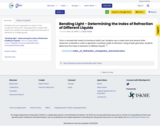
Conditional Remix & Share Permitted
CC BY-NC
Mixed format assessment (mutliple choice, fill in the blank, short answer) covering reflection, refraction, visible spectrum, waves and opacity. There is a question at the end of the test over scientific investigation design and light.
- Subject:
- Force/Motion/Energy
- Material Type:
- Lesson Plan
- Author:
- Erin Brown
- Date Added:
- 07/25/2019
